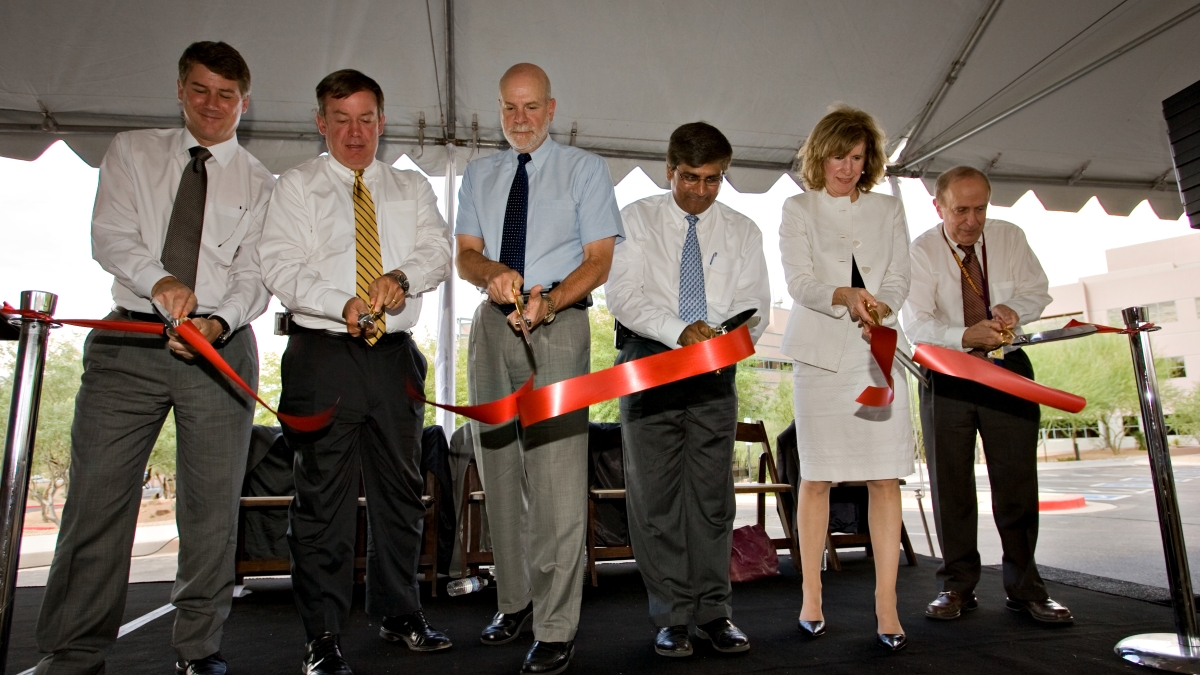ASU, Mayo Clinic deepen partnership in health care, medical research

Arizona State University recently moved its Biomedical Informatics department to the Scottsdale campus of Mayo Clinic as part of the university’s deepening ties with Mayo in health care, medical research and education.
Housing ASU’s Biomedical Informatics department on the Mayo campus will allow ASU students enrolled in the program to work side-by-side with practicing Mayo Clinic physicians, creating a greater opportunity to advance biomedical informatics research and technology.
The opening of ASU’s BMI offices on Mayo Clinic’s campus was recognized Aug. 25, with a ribbon-cutting ceremony.
Among the dignitaries in attendance were legislators Michelle Ugenti, Cecil Ash and Heather Carter; Jim Lane, Scottsdale mayor; councilwoman Suzanne Klapp; and Arizona Board of Regents member Bob McLendon.
“Making BMI’s home at Mayo Clinic will advance biomedical informatics education and research in new and exciting ways,” said ASU President Michael M. Crow. “By doing this, we are connecting students, faculty, researchers and clinicians in ways that will lead to advancing the science, technology and usefulness of biomedical informatics.”
“We welcome the BMI program to our Mayo Clinic campus and are excited about this potential to merge the best minds in research and clinical disciplines in the pursuit of health care solutions in the age of personalized medicine,” said Wyatt Decker, Mayo Clinic CEO. “This collaboration underscores the dramatic growth in the field of biomedical informatics and its importance to unraveling the mysteries of human diseases.”
Moving ASU’s BMI department to Mayo is one of many collaborations between the two entities, including:
• a joint nursing education program;
• a variety of collaborative research projects;
• joint faculty appointments;
• dual degree programs including M.D./J.D. and M.D./M.B.A;
• joint work on the new Proton Beam Program; and
• sharing in development of Mayo’s new Center for the Science of Health Care Delivery.
Biomedical informatics is a burgeoning field at the intersection of information science, computer science and health care. Biomedical informatics promises to lead to new discoveries in health care, new ways to treat diseases and new methods, such as individualized medicine, that more precisely treat patients.
Putting the BMI department on the Mayo campus will help it thrive, according to Sethuraman “Panch” Panchanathan, ASU’s chief research officer.
“In order to advance biomedical informatics education and research, we need to be embedded in a clinical environment,” Panchanathan said. “Mayo provides access to world-class physicians and researchers in Arizona, as well as in Minnesota and Florida. It provides extraordinary opportunities for ASU faculty and students to work in one of the top clinical facilities in the country and advance education, research and training in biomedical informatics.”
Robert Greenes, ASU’s Ira A. Fulton chair and professor of the Biomedical Informatics department, said the new home will directly benefit BMI students.
“The proximity to Mayo clinicians and researchers, and actual patient care settings will enable BMI students to identify and work closely with real-world problems in health care delivery and the underlying science,” Greenes explained. “This provides an invaluable opportunity for students, faculty, researchers and clinicians to form collaborations addressing these problems, and jointly coming up with innovations and improvements in the health care system.”
“ASU BMI has a commitment to academic research with an applied focus, and is ready and able to provide a range of faculty and student talent to work on problems of interest and relevance to Mayo Clinic, both in terms of its biomedical science goals and its health care delivery and health improvement goals.”
Keith Frey, chief medical information officer at Mayo Clinic in Arizona and a clinical professor in the BMI department, said this set up will help usher in the age of personalized medicine.
“The patient will be the ultimate beneficiary of this unique collaboration between outstanding students and faculty from ASU and the best clinical and research minds at Mayo Clinic,” Frey said. “By working to analyze a patient’s genetic profile, we begin to more precisely understand the molecular genesis of many diseases, and thereby are able to advance better treatments and cures. “

